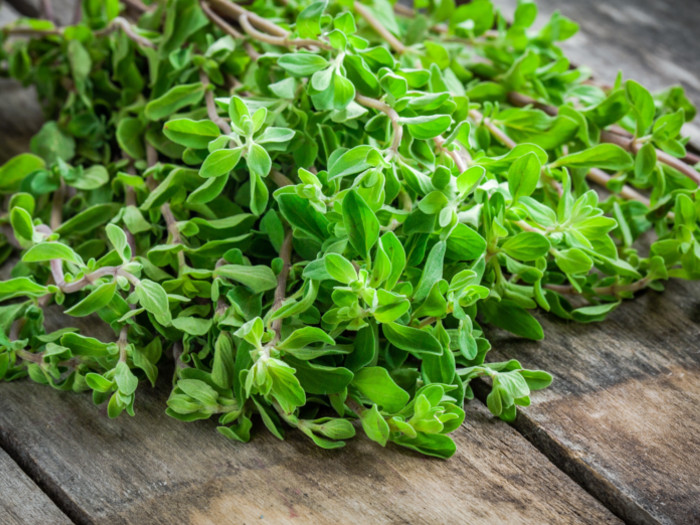In many places, marjoram is just another name for oregano, but the two plants have very different tastes and benefits.
What is Marjoram?
Marjoram is a small flowering shrub that is a subspecies of oregano, both being members of the mint family, Lamiaceae. It is a native Mediterranean plant, found in Cyprus and Turkey, although it is grown all over the world now since its popularity as a spice has boomed. It has a sweet, mild taste with notes of citrus and pine. This light floral herb is often used in salad dressings and marinades. Fresh or dried, it does not stand up to heat well during cooking and works better in cold cooking applications. It is not only prized for its flavor, but also for its potential health effects.
Serving Size : Nutrient Value Water [g] 7.64 Energy 271 Energy [kJ] 1136 Protein [g] 12.66 Total lipid (fat) [g] 7.04 Ash [g] 12.1 Carbohydrate, by difference [g] 60.56 Fiber, total dietary [g] 40.3 Sugars, total including NLEA [g] 4.09 Calcium, Ca [mg] 1990 Iron, Fe [mg] 82.71 Magnesium, Mg [mg] 346 Phosphorus, P [mg] 306 Potassium, K [mg] 1522 Sodium, Na [mg] 77 Zinc, Zn [mg] 3.6 Copper, Cu [mg] 1.13 Manganese, Mn [mg] 5.43 Selenium, Se [µg] 4.5 Vitamin C, total ascorbic acid [mg] 51.4 Thiamin [mg] 0.29 Riboflavin [mg] 0.32 Niacin [mg] 4.12 Vitamin B-6 [mg] 1.19 Folate, total [µg] 274 Folate, food [µg] 274 Folate, DFE [µg] 274 Choline, total [mg] 43.6 Vitamin A, RAE [µg] 403 Carotene, beta [µg] 4806 Cryptoxanthin, beta [µg] 70 Vitamin A, IU [IU] 8068 Lutein + zeaxanthin [µg] 1895 Vitamin E (alpha-tocopherol) [mg] 1.69 Vitamin K (phylloquinone) [µg] 621.7 Fatty acids, total saturated [g] 0.53 16:0 [g] 0.29 18:0 [g] 0.24 Fatty acids, total monounsaturated [g] 0.94 18:1 [g] 0.94 Fatty acids, total polyunsaturated [g] 4.41 18:2 [g] 1.18 18:3 [g] 3.23 Phytosterols [mg] 60 Sources include : USDA [1]
Nutrition
1 tablespoon of the herb contains 5 calories, 1 gram of carbs, 25 mg of potassium, and 1 mg of sodium. It also has 0.2 grams of protein and 0.7 grams of fiber.
Health Benefits
Being a rich source of antioxidants, marjoram is often prescribed for the following: [2]
- Supports digestion
- Stimulates appetite
- Prevents gallstones
- Treats gastric ulcers
- Promotes heart health
- Dilates blood vessels
- Lowers blood pressure
- Improves cardiovascular health
- Reduces anxiety
- Lowers stress
- Improves emotional health
- Treats neurological health
Due to its antimicrobial and anti-inflammatory properties, inhaling its oil provides protection against the following: [3]
- Cough and cold
- Headache
- Nerve pain
- Muscle pain
- Diabetes

Marjoram is a cold-sensitive perennial herb with sweet pine and citrus flavors. Photo Credit: Shutterstock
When taken as a tincture, it is thought to help alleviate the symptoms of asthma by allowing for better, more open breathing. [4]
It is a well-known herbal treatment for women’s health issues. It is used for the following: [5]
- Menstrual cycle support
- Treat menopause symptoms
- Restores hormone balance
- Treats polycystic ovarian syndrome
- Reduces androgen levels
Marjoram vs. Oregano
- Origin: Marjoram is a subspecies of oregano, and the two are often mistaken for each other. In some regions, oregano is called wild marjoram, and marjoram is referred to as sweet marjoram, as a means to differentiate.
- Taste: As those names suggest, the tastes of both herbs are very different. Oregano is very pungent and earthy tasting, with a heavy, overwhelming scent. Marjoram is lighter, with more subtle floral sweetness.
- Cuisines: Oregano is common in Italian and Mediterranean dishes, while marjoram is more common in English and French cuisine.
- Usage: Both essential oils are powerful antiseptics, but oregano is harsher and is used more frequently to treat infections like fever or rash. Marjoram is milder and is used more commonly for stress, respiratory disorders, and as an anti-inflammatory substance. [6]
Side Effects
This herb is not recommended for women during pregnancy or while breastfeeding due to its powerful hormonal and menstrual effects.
Furthermore, caution is advised, if you are on medication for the following:
- Ulcers
- Bradycardia
- Bleeding disorders
- Scheduled for surgery
If you have an allergy to basil, hyssop, lavender, mint, oregano, and sage, you may have a cross-reaction to this herb in its various forms.
Some of the other side effects can include contact dermatitis or constipation; if you notice any of these issues, discontinue use immediately.
